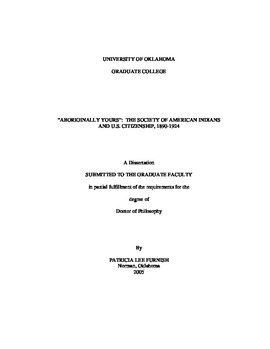| dc.contributor.advisor | Anderson, Gary C., | en_US |
| dc.contributor.author | Furnish, Patricia Lee. | en_US |
| dc.date.accessioned | 2013-08-16T12:20:00Z | |
| dc.date.available | 2013-08-16T12:20:00Z | |
| dc.date.issued | 2005 | en_US |
| dc.identifier.uri | https://hdl.handle.net/11244/962 | |
| dc.description.abstract | His public life had been dedicated to improving the condition of Native people. Eastman worked with progressive reformers who, like himself, believed in the power of Christian civilization and democracy to improve the condition of Indians. These "Friends of the Indian" organizations abhorred massacres of Indians and the institutional disgrace that Indian reservations signified. During the Progressive Era 1890-1917, Eastman helped found a political organization of Native Progressive reformers, the Society of American Indians (SAI), in 1910. They came to know the political and racial power structure of the United States as it was shaped by two wars, the Spanish American War and World War I. The SAI pushed for assimilation with consent, a racial uplift created with Indian participation and with respect for Indians as human beings. With a lifespan of less than fifteen years, the SAI's anti-climactic implosion revealed the elusiveness of full citizenship and the dismal record of social reform during World War I. | en_US |
| dc.description.abstract | This study examines the issues of cultural identity and rights of access to full participation in American society for American Indians. Leaders of the SAI pushed for Indian assimilation through U.S. citizenship, which is in one respect, a legally defined status and one that the federal government retained the constitutional power to grant. SAT leaders, however, were divided on many issues---policy, assimilation, and the proper path for the development of a viable, modern Indian identity. The official rhetoric of the SAI changed little over its thirteen years of activity. However, the philosophies of its key members did. As tribal members from across the country joined the SAI in an effort to form a pan-Indian "voice" on federal Indian policy, they found disagreement over the process of gaining citizenship for Indians. Issues of tradition versus acculturation challenged the SAI's philosophy of a unified agenda beneficial and representative of all citizen Indians in the United States. On both a philosophical and a personal level, leaders of the SAI had to confront their own issues of Indian identity and the stereotypes of Indians that influenced federal policy. (Abstract shortened by UMI.) | en_US |
| dc.description.abstract | In 1890, the last spasm of Indian-U.S. military conflict at Wounded Knee convulsed Pine Ridge reservation. A Santee Sioux physician, Charles Eastman witnessed the massacre of approximately three hundred members of a Minneconjou Sioux band led by Big Foot, mostly women and children. | en_US |
| dc.format.extent | xii, 183 leaves ; | en_US |
| dc.subject | Sociology, Ethnic and Racial Studies. | en_US |
| dc.subject | Indians of North America Legal status, laws, etc. History 20th century. | en_US |
| dc.subject | Society of American Indians. | en_US |
| dc.subject | Indians of North America Cultural assimilation History 20th century. | en_US |
| dc.subject | History, United States. | en_US |
| dc.subject | Indians of North America Government relations 1869-1934. | en_US |
| dc.title | "Aboriginally yours": The Society of American Indians and United States citizenship, 1890--1924. | en_US |
| dc.type | Thesis | en_US |
| dc.thesis.degree | Ph.D. | en_US |
| dc.thesis.degreeDiscipline | Department of History | en_US |
| dc.note | Adviser: Gary C. Anderson. | en_US |
| dc.note | Source: Dissertation Abstracts International, Volume: 66-12, Section: A, page: 4502. | en_US |
| ou.identifier | (UMI)AAI3203322 | en_US |
| ou.group | College of Arts and Sciences::Department of History | |
